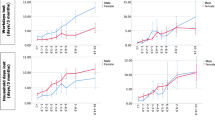Abstract
OBJECTIVE: To assess the long-term impact of headache on labor force participation among primary care patients with headache.
DESIGN: A 2-year cohort study comparing employment status of primary care patients with headache and that of patients with back pain.
PARTICIPANTS: Patients with headache (n=662) or back pain (n=1,024) sampled from persons visiting a primary care physician who completed baseline, 1-year and 2-year follow-up interviews.
MEASUREMENTS AND MAIN RESULTS: The percentage of subjects unemployed at baseline, 1 year or 2 years was determined, excluding the retired and homemakers. Among all patients, the percentage unable to obtain or keep full-time work in the year prior to each interview because of headache or back pain was also assessed. Over the 3-year period covered by the study interviews, 13% of headache and 18% of back pain patients were unable to obtain or keep full-time work because of their pain condition. Among those in the labor force, 12% of headache patients and 12% of back pain patients were unemployed for any reason at one or more interviews. Among the one in five headache patients with a poor longterm outcome, 36% were unable to obtain or keep full-time work because of headache at some time compared with 4% of headache patients with a good outcome. Among headache patients, women, persons aged 18 to 24 years, those with lower levels of education, persons with depressive symptoms, and migraineurs were more likely to have reduced labor force participation owing to headache.
CONCLUSIONS: The likelihood of reduced labor force participation among primary care patients with headache was considerable and concentrated among the one in five patients with a poor long-term outcome. Headache patients at a social disadvantage in attaining occupational role stability (e.g., younger women or poorly educated patients) were more likely to report reduced labor force participation.
Similar content being viewed by others
References
Sternbach RA. Survey of pain in the United States: the Nuprin pain report. Clin J Pain. 1986;2:49–53.
Von Korff M, Dworkin SF, Le Resche L, Kruger A. An epidemiologic comparison of pain complaints. Pain. 1988;32:173–83.
American Academy of Family Physicians. Facts About: Family Practice. Kansas City, Kan: American Academy of Family Physicians; 1987.
Schappert SW. National Ambulatory Medical Care Survey: 1989 Summary. National Center for Health Statistics. Vital Health Stat. 13. 1992;110.
Osterhaus JT, Gutterman DL, Plachetka JR. Health care resource use and lost labour costs of migraine headache in the US. Pharmaco-Economics. 1992;2(1):67–76.
Stang PE, Osterhaus JT. Impact of migraine in the United States: data from the National Health Interview Survey. Headache. 1993;33:29–35.
Stewart WF, Lipton RB, Celentano DD, Reed ML. Prevalence of migraine headache in the US. JAMA. 1992;267:64–9.
Rasmussen BK, Jensen R, Olesen J. Impact of headache on sickness, absence and utilization of medical services: a Danish population survey. J Epidemiol Commun Health. 1992;46:443–6.
Von Korff M, Ormel J, Keefe FJ, Dworkin SF. Grading the severity of chronic pain. Pain. 1992;50:133–49.
Derogatis LR. SCL-90-R: Administration, Scoring and Procedures Manual-II for the Revised Version. Towson, Md: Clinical Psychometric Research; 1983.
Linet MS, Stewart WF, Celentano DD, et al. An epidemiologic study of headache among adolescents and young adults. JAMA. 1989;261:2211–6.
Headache Classification Committee of the International Headache Society. Classification and diagnostic criteria for headache disorders, cranial neuralgias, and facial pain. Cephalagia. 1988;8(suppl 7):19–28.
Saunders KW, Stergachis A, Von Korff M. Group Health Cooperative of Puget Sound. In: Strom BL, ed. Pharmacoepidemiology. New York, NY: John Wiley and Sons; 1994.
Author information
Authors and Affiliations
Additional information
Supported by grants from the Agency for Health Care Policy and Research (RO1 HS06168) and the National Institute of Dental Research (PO1 DE08773), and Glaxo Research Institute. The contributions of Kathleen Saunders to this research are gratefully acknowledged.
Rights and permissions
About this article
Cite this article
Stang, P., Von Korff, M. & Galer, B.S. Reduced labor force participation among primary care patients with headache. J GEN INTERN MED 13, 296–302 (1998). https://doi.org/10.1046/j.1525-1497.1998.00094.x
Issue Date:
DOI: https://doi.org/10.1046/j.1525-1497.1998.00094.x




